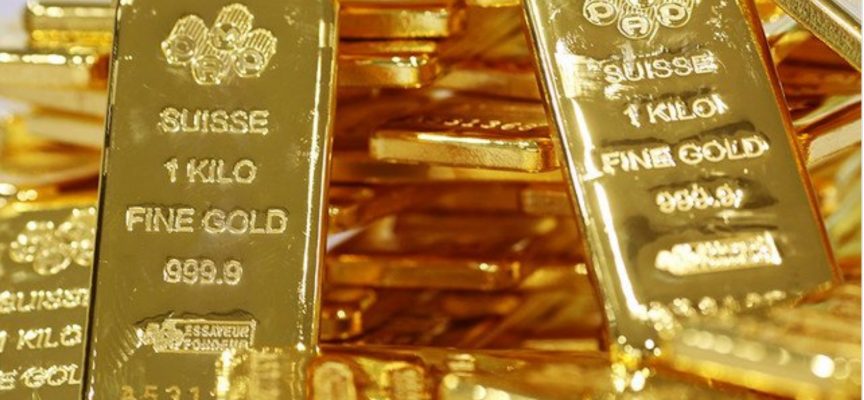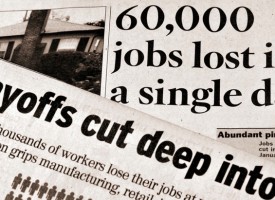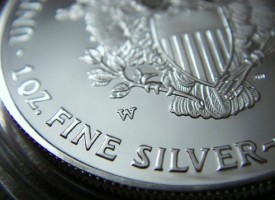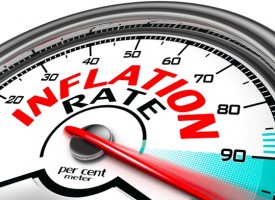Expect more massive market turmoil as things are breaking but gold is about to shine again.
Things Are Breaking
October 6 (King World News) – Paul Wong, Market Strategist at Sprott Asset Management: September review. Gold fell $50.43 (or -2.95%) to close at $1,660.61 for the month. After several tests over the past few years, gold finally fell below the $1,700 support level as the U.S. dollar (USD) made 20-year highs and real yields made 12-year highs. In a rare occurrence, the USD and real yields have surged simultaneously the most in the past 25 years, a significant tightening of financial conditions.
September saw substantial losses in most asset classes except the USD and volatility. The Fed has now conducted three 75 bps rate hikes in a row to bring Fed Funds to 3.25%, and market expectations of the terminal are now at 4.50%-4.75%, a level that we believe has severe growth consequences. Geopolitical war tensions increased further (natural gas flows shut, pipeline sabotage, land annexation, nuclear threats). But the most significant development is the ongoing crisis in the United Kingdom (UK). Market tension in FX and rates have likely broken the UK bond market and highlighted the fragility and risks in the global financial system. Figure 1 highlights the year-to-date returns for various asset classes and the degree of market pain across all risk assets.
Gold Bullion Update
Gold held above $1,700 since Q2 2020, but in mid-September this year, a significant risk-off wave occurred, breaking nearly every risk asset lower. Again, the primary cause was higher than expected inflation data forcing yields (especially real yields) and the USD higher, two important gold drivers. With $1,700 support broken, the next level of support is about $1,550, the approximate pre-COVID trade level (see Figure 2). Relative to most asset classes, gold continues to outperform in a broad-based bear market.
Gold Currently $1,721
Fed Hikes Causing Soaring USD and Real Rates, A Toxic Mix
At Jackson Hole and the September Federal Open Market Committee (“FOMC”) Meeting, the Fed emphatically messaged there would be no pause or dovish pivot until inflation is on a sustainable path lower towards their 2% target. In addition, QT (quantitative tightening) has now ramped up to $60 billion in Treasuries and $35 billion in MBS, which at a combined $90 billion per month is much higher than 2018’s $50 billion monthly runoff. The Fed is compelled to hike to force an intentional hard landing to push the economy, stocks and the housing market lower to cause demand destruction to stop inflation. A delay in demand destruction increases the probability of a recession (and a deeper one), as the Fed will have no choice but to lean even more hawkish.
Though the Fed’s mandate is domestic, it effectively sets monetary for the rest of the world, and everything reflects U.S. monetary policy. But by hiking so aggressively and having a higher neutral rate than most countries, other currencies are weakening, leading to high trade deficits, import bills and passthrough inflation. Effectively the U.S. is exporting stagflation to the rest of the world by hiking rates (slow economies) and weakening non-U.S. currencies (passthrough inflation)…
ALERT:
Billionaire and mining legend Ross Beaty, Chairman of Pan American Silver, just spoke about what he expects to see in the gold and silver markets and also shared one of his top stock picks in the mining sector CLICK HERE OR ON THE IMAGE BELOW TO HEAR BEATY’S INTERVIEW.

Along with the economic impact, Fed policy also impacts all asset classes globally by tightening financial conditions. Spiking real yields is negative for equities, bonds, commodities, gold, cryptos, and any risk asset. Real yields have spiked as breakeven yields have rolled over due to growth concerns, while nominal yields have soared in response to the hawkish Fed (real yields equals breakeven minus nominal yields). Figure 3 highlights how extreme the combined surge in real yields and the USD has been this year. This high rate of change for both is toxic for risk assets, and as the Fed steps up the pressure, things are starting to break. At some point, the Fed will break something, and as the defacto world’s central bank, it will need to fix it.
Currency Markets Under Stress
DXY, the U.S. Dollar Index, is at a 20-year high, but the frenetic rate of increase is acting like a wrecking ball on the FX markets. Other central banks need to hike rates if the Fed is hiking rates. If not, their currencies will weaken, and trade deficits and passthrough inflation are likely to soar. If other central banks hike rates, their economy will slow and likely faster than the U.S. since the U.S. will have a higher neutral rate. Supporting a currency requires a combination of increasing interest rates and liquidating reserves to purchase one’s currency. The reality is no central bank can out hawk the Fed currently, and there are no good options.
As signs of cracks in the currency markets begin to show due to the untenable rise of the USD, a coordinated currency intervention (Plaza Accord type agreement) is possible. But such an action would counter the Fed’s inflation fight by easing financial conditions (lower USD and lower real yields). The Fed may need to find a way to arrest USD strength but still allow further monetary policy tightening before systematic financial risk increases further…
This Is Now The Premier Gold Exploration Company In Quebec With Massive Upside Potential For Shareholders click here or on the image below.
UK Financial Crisis
No other reserve currency is in a perilous state as the British pound (GBP) and, by extension, the British bond market (gilts) and its financial system. In short, there was a market revolt in financing the UK fiscal budget, which entailed funding energy and electricity bills for consumers and tax cuts for the rich at deep negative real rates. At the same time (unbelievably), the UK would also sell bonds via QT. The market voted with its feet, yields soared and the pound collapsed, reminiscent of an emerging market in crisis (see Figure 4). The degree of the sell-off in gilts and GBP triggered margin calls on derivative and leveraged repo positions in pension plans, and the resultant waves of forced liquidation began a death spiral. The BoE (Bank of England) was then forced to launch” temporary” QE (quantitative easing) to buy unlimited amounts of long-dated gilts to prevent pensions and their financial system from collapsing.
This action was a pension plan bailout using a funding process of printing new reserves with a currency in a significant drop to buy interest-bearing versions (long-dated gilts) of the same currency from yourself. Meanwhile, the BoE is still planning for QT to continue after this (brief) side trip to QE. If this sounds absurd, you are not alone. The UK financial crisis signifies that central banks are left with no good options. Central banks absolutely cannot allow inflation to run wild and become embedded. But by tightening policy (rate hikes and QT) to fight inflation, there is an elevated risk of systemic meltdowns. The UK was the first to pivot, but it may not be the last. The longer-term question is the UK, a G7 developed economy with a reserve currency, is losing its ability to operate in an MMT (modern monetary theory) structure.
Volatility Behaving Different this Time
Over the past 40 years, cross-asset volatility (“vol”) typically began with equity volatility surging first, followed by commodities, credit, FX and finally, rates. Rates volatility was the last to rise (no inflation, low/weak growth, deflation risk) and when rate volatility eventually rose; it was likely a sign that the then accommodative central banks were preparing to cut rates (the left tail risk) to stabilize and start the recovery in risk assets. Figure 5 highlights this sequence has been reversed this year due to the inflation fight. Figure 5 is a normalized measure (5-week average divided by 200-week average) for the equity, bond, currency volatility and investment grade CDS. Bond volatility is leading, followed by currency, CDS and equity volatility. Equity volatility has lagged but appears primed to catch up with the other volatility measures.
While gold has performed relatively well against other asset classes (see Figure 1), it appears to reflect the lack of panic, as seen in equity volatility in Figure 5. Figure 6 summarizes this observation quickly. GVZ (CBOE Implied Gold Volatility Index) has a high R-square (0.71) to equity volatility (VIX) but not to the other classes. In other words, gold volatility only seems to react to equity volatility. Gold volatility has a positive skew (gold volatility rises with gold prices), unlike most asset classes, and is a feature of its safe-haven behavior. It seems likely that equity volatility will spike in a delayed manner and that GVZ and gold prices may follow. When equity volatility finally does spike, will this be the sign that we are closer to the Fed pause/pivot? After 40 years, especially since the GFC (global financial crisis), the market’s conditioned response is a Fed pivot when the market succumbs to panic. Whether the Fed ultimately pivots or not, the market likely will discount the pivot ahead of time.
Gold Positioning at Decade Trend Lows
In Figure 7, we show how CFTC-managed futures are positioned. The top panel is the longs (CTA and the like) converted to million ozs, at the low end of its 10-year range. The bottom panel is CTA short positions in mils ozs and is near the upper end. For CTAs to break gold lower, they would need to pile on the shorts as they did back in 2018. That short-selling action did not work out well, as the Fed had to abandon QT/hikes after the stock market started crashing and the repo markets froze up.
The other large cohort of tradeable gold would be the gold held in ETFs (exchange-traded funds) and CFTC Other Reportables. In Figure 8, we break down these holdings into Non-GLD gold in ETFs (the “sticky money,” no options, mostly retail) and gold held in GLD (retail and smaller firms, extensive options). CFTC Other Reportables are smaller firms that trade futures (i.e., family offices). Note that Non-GLD ozs have grown to twice the size of GLD (not including GLD options) and are now the largest gold cohort. As more gold is locked away in stickier buy-and-hold hands, the CTA types will significantly influence short-term pricing effects.
Non-GLD gold in ETFs bucket (the sticky money) is ~12 mil ozs above pre-COVID levels, while GLD and the other reportable group are back or close to their pre-COVID levels. Managed futures would have to go extremely short, and the sticky money would need to capitulate to break gold lower. Meanwhile, over the summer, China, India and central banks increased their buying with lower gold prices. Positioning-wise, gold prices are highly amendable to a price squeeze.
Travels in Hyper-Correlations
As 2022 progressed, we saw increasing levels of asset correlation. Figure 9 shows the extreme correlations we believe will reverse as this macro trade unwinds. The chart overlays the yen, U.S. 10-year real yields, gold (inverted axis), and since March (war and inflation), it has been highly correlated. With the trade several months in and profitable but increasing signs of pushback from policymakers as market stress builds, this entire trade is open for reversal. Add in the poor state of market depth (trading liquidity) and gold bullion positioning (Figures 7 & 8), the conditions are there for a price squeeze higher under the proper conditions. Hypercorrelated trades tend to end violently.
Figure 9. Yen, Real Rates and Gold One Big Extended Trade (2021-2022)
The Cracks Are Showing
The development in the UK is another sign that markets are at risk when liquidity is withdrawn after decades of expanding monetary policies. Policymakers have started to react to the growing risk in markets and economies due to rising yields and the USD (i.e., currency interventions, reserve requirements). Red flags developing in the yen, yuan, euro, and especially the pound and gilts are all signaling that cracks are now showing up in FX and rates. The tightening phase has reached the point where credit stress is rising and available credit liquidity is falling to the point where market accidents tend to happen. The adverse market effects of QT forced the Fed to pivot in 2018 and will likely cause the UK to do the same, and perhaps more to follow. The signs of higher rates and QT nearing the end are coming into sight, but not before more market turmoil.
Keynote Speeches To IMF, World Bank & Federal Reserve
To listen to Nomi Prins discuss the gold market, the emergency Bank of England intervention in the UK, crisis in Europe, what to expect next for the US dollar and much more CLICK HERE OR ON THE IMAGE BELOW.
To listen to Alasdair Macleod discuss the crisis unfolding in the UK and Europe as well as why the gold and silver markets are poised to rally CLICK HERE OR ON THE IMAGE BELOW.
© 2022 by King World News®. All Rights Reserved. This material may not be published, broadcast, rewritten, or redistributed. However, linking directly to the articles is permitted and encouraged.




















